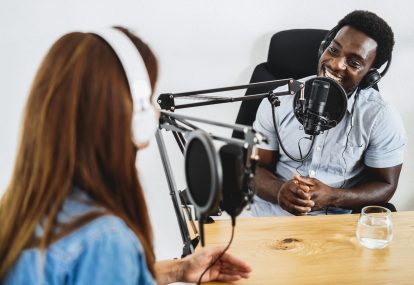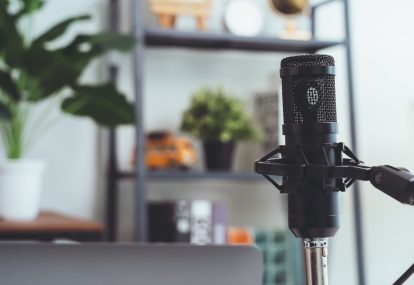With all things considered, audio clarity is the most crucial for a podcast. Your recordings must be reverb-free, giving your voice a chance to shine can be as simple as clearing out the noise from other sources. Having the room set up in a way where you can get creative with fewer problems on the audio can be beneficial. It will allow you and your avid listener to have an amazing experience as well.
Podcasters aim to reduce reverb when recording. And having the right recording space set up must be greatly considered.
With that in mind, here is a guide on how to set up your recording space and maximize the audio quality of your podcast.
You can make your voice sound like an amateur with these free options. Some of these tips might be familiar, but there’s always something new to learn. Doing this can help you save on expenses and allocate your resources to other things like investing in acoustic treatment.
What reverb is and how to identify it?
Reverb is essentially echo. Although there are technical differences between the terms (“reverb” and “echo”), in the context of recording spoken words in a relatively small, enclosed room, we can treat the two terms as the same and use them interchangeably.
A common problem with reverb can be identified by the audio sounding “thick” rather than crisp. The actual words that are spoken will be surrounded by an echo that is of a similar pitch and tone to your voice, but that is garbled in itself.
The best way to work out whether a lack of audio fidelity on your podcast is caused by reverb or some other technical issue is to ask yourself: “does the unwanted noise that is muddying my recording sound similar to my voice”.
In particular, you want to check whether this unwanted ambient noise vaguely follows the intonation of your voice. If this is the case, then reverb is likely the problem. If the background noise does not at all follow your intonation then it is likely due to a separate technical issue.
Now we have identified that reverb is the culprit for our poorer-than-expected sound quality, let’s look at some of the ways that we can reduce the reverberation in a room.
How to reduce reverb in a room without spending any money
Sit opposite a wall, rather than windows
Reverb is caused by sounds being reflected off surfaces. Harder surfaces reflect sound waves more effectively than softer surfaces. Therefore, you want to avoid sitting directly opposite a window when recording, as glass is a very sound-reflective surface.
Although walls are still reflective, they are significantly less so than glass, so sitting opposite a wall, as opposed to a window can quite drastically reduce the amount of reverberation in your recording.
A quick tip: You want to avoid having windows either in front or behind you when recording.
Ideally, windows should have blinds or curtains drawn to offer a softer physical barrier between the sound waves coming out your mouth and glass surfaces.
Sit in the middle of the room
You want to be sitting in the middle of the room, so there is equal space between yourself and each adjacent wall to you. The reason for this is that reverb builds up the most in the corners of the room as the sound waves bounce off two walls simultaneously. You, therefore, want to be as far away from a corner of a room as possible.
Please note the distinction between us saying that you should sit in the middle of the room and that you should sit in the centre of the room. You want to have a sound-absorbing surface close to your mouth. Even if the surface is not sound reflective (a wall, for example) you still want it to be around two feet away from your mouth. Therefore you want to sit close to a wall in front of you, but as far away from adjacent walls as possible.
Place furniture in the corners of your room
To avoid echoey spots in your room, you can use soft furniture like chairs and sofas. Place these items near where it sounds best for sound to bounce around before coming out of the other side rather than reflecting off a hard surface directly back at ourselves. You can try using an extra chair or two if possible.
Cover your monitor
Recording in front of a monitor is a common mistake for a podcaster. As mentioned, glass is an excellent sound-reflective material, and its close proximity to your face while recording can result in some pretty awful audio quality.
There are two ways to reduce the reverberation caused by having your screen close to you. One option is either moving or draping something over it, like a blanket for example.
Inexpensive ways of reducing reverb
If you decide to spend money on equipment to improve the audio quality of your podcast, you should remember that the two most important parts of your room to try and eliminate sound reflection are the corners of the room and the space directly in front of you and behind you. Treating the flat surface walls adjacent to you brings diminishing returns.
The three first products that you should buy to reduce reverb are, therefore (in order of importance):
- A microphone isolation shield to absorb as much sound as possible at the source
- Corner bass traps to minimize noise reflection in the corners of the room (prioritize the corners closest to where you sit)
- Acoustic panels to minimize noise reflection off the faces of walls
Acoustic panels are generally purchased in squares of two by four feet. To get the most value start by paneling up the wall directly behind where you are sitting and work outwards from there. The further from your panels, the less of an impact they have on reducing reverb.
You might be surprised by how much of this you can achieve in an inexpensive DIY. Reducing the reverb is a key component to achieving high audio quality. And fortunately, it doesn’t have to cost you so much.
No matter where you are in your podcast journey our expert podcast editors will help you sound your best. Schedule a consultation and let’s get started!
This article was written by Volodymyr Barabakh, the Project Director of design and build company Fortress Home. For more information please visit: https://fortresshome.com/




